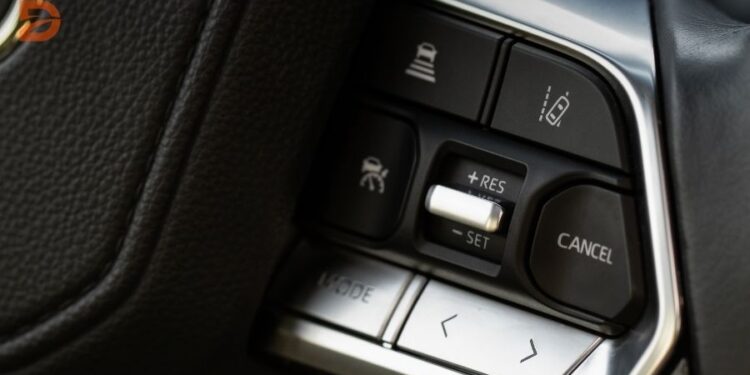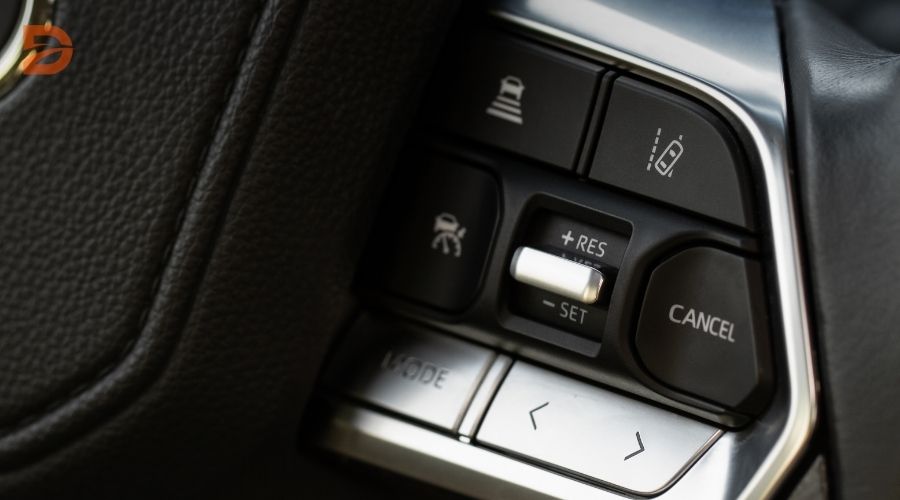In the ever-evolving landscape of automotive technology, one feature stands out as a game-changer for both driver safety and comfort: Adaptive Cruise Control (ACC). But have you ever wondered, How this intelligent technology works, and what are the real-world benefits it offers?
Adaptive Cruise Control is a key component of future generations of intelligent cars, enhancing passenger safety and convenience while increasing road capacity. It automatically controls the acceleration and braking of a vehicle to maintain a safe following distance from the car ahead, allowing drivers to enjoy a more relaxed and comfortable driving experience. ACC is becoming increasingly common in new vehicles as sensor technology has become more affordable.
Key Takeaways:
- Adaptive Cruise Control operates within the speed range of 0 to 95 mph once activated.
- The stop-and-go feature is included in all model year 2024 vehicles.
- ACC technology is considered a key component of future intelligent cars, enhancing safety and convenience.
- ACC systems can cost between $500 to $2500, depending on the type and model of the car.
- Advantages of ACC include convenience, speed consistency, and improved fuel efficiency.
What is Adaptive Cruise Control?
Adaptive cruise control (ACC) is an advanced driver-assistance system that automatically adjusts a vehicle’s speed to maintain a safe distance from the car in front. This intelligent technology uses onboard sensors, such as radar, laser, or camera systems, to detect the presence and speed of other vehicles on the road. By continuously monitoring the flow of traffic, ACC can enhance driving convenience, reduce driver fatigue, and improve fuel efficiency by maintaining a consistent speed.
Definition and Basic Functionality
Adaptive cruise control is an enhancement to traditional cruise control, providing more advanced capabilities. Unlike traditional cruise control, which maintains a constant speed set by the driver, ACC automatically adjusts the vehicle’s speed to match the flow of traffic and maintains a safe following distance. This is achieved through the use of sensors that continuously monitor the vehicle’s surroundings and make real-time adjustments to the speed as needed.
Key Advantages of ACC
- Enhanced driving convenience: ACC handles speed adjustments in response to traffic flow, reducing the need for the driver to constantly adjust the throttle and brakes.
- Reduced driver fatigue: By automatically maintaining a safe following distance and adjusting the vehicle’s speed, ACC can help alleviate the mental strain of long drives or heavy traffic conditions.
- Improved fuel efficiency: ACC’s ability to maintain a consistent speed can contribute to reduced fuel consumption and emissions, as the vehicle is not constantly accelerating and braking.
| Feature | Benefit |
|---|---|
| Automatic speed adjustment | Enhances driving convenience and reduces driver workload |
| Maintains safe following distance | Helps prevent collisions and reduces driver fatigue |
| Consistent speed maintenance | Improves fuel efficiency and reduces emissions |
How Adaptive Cruise Control Works
Adaptive Cruise Control (ACC) is an advanced driving assistance feature that enhances the comfort and safety of the driving experience. This innovative system utilizes various sensor technologies to monitor the road ahead and automatically adjust the vehicle’s speed and following distance, providing a seamless and efficient journey.
Sensor Technologies: Radar, Laser, and Camera Systems
ACC systems employ a combination of sensor technologies to detect the presence and distance of other vehicles on the road. Radar-based systems use radio waves to identify the location and speed of surrounding vehicles, while laser-based systems utilize LIDAR (light detection and ranging) technology for more precise measurements. Some advanced ACC systems also incorporate camera-based computer vision to further enhance their detection capabilities.
Speed and Distance Adjustments
Based on the sensor data and the driver’s selected preferences, the ACC system automatically adjusts the vehicle’s speed and maintains a safe following distance. When the system detects a slower-moving vehicle ahead, it will gradually reduce the vehicle’s speed to match the speed of the lead vehicle, ensuring a safe and comfortable following distance. Conversely, when the lead vehicle accelerates or changes lanes, the ACC system will smoothly increase the vehicle’s speed to maintain the desired speed and distance.
The integration of adaptive cruise control with advanced driver assistance technologies, such as lane centering, enables even more seamless and efficient driving experiences, contributing to the progression toward autonomous driving capabilities.
Types of Adaptive Cruise Control Systems
Adaptive cruise control (ACC) technology has evolved significantly, offering drivers a range of advanced features to enhance safety and comfort on the road. From radar-based systems to state-of-the-art multi-sensor approaches, the types of ACC available today cater to diverse driving needs and environments.
Radar-based ACC systems utilize radio waves to detect the presence and speed of surrounding vehicles, automatically adjusting the host vehicle’s speed to maintain a safe following distance. These systems excel in open highway scenarios, providing a smooth and responsive driving experience.
Laser-based ACC solutions, on the other hand, leverage LIDAR (Light Detection and Ranging) technology to gather detailed information about the vehicle’s surroundings. While often less expensive and physically smaller than radar-based counterparts, laser-based systems may have a narrower range of detection.
Binocular computer vision ACC systems employ advanced camera technologies to analyze the driving environment. By processing images from multiple angles, these systems can provide a comprehensive understanding of the road ahead, enabling more accurate speed and distance adjustments.
For a more holistic approach, multi-sensor ACC systems integrate various detection technologies, such as radar, laser, and cameras, to create a robust and redundant sensing network. This approach can enhance the system’s reliability and performance, particularly in challenging driving conditions.
The latest evolution in ACC is the predictive ACC, which uses advanced algorithms to anticipate the actions of nearby vehicles. By analyzing traffic patterns and driver behaviors, these systems can proactively adjust the vehicle’s speed, further improving safety and driving comfort.
As adaptive cruise control continues to evolve, drivers can look forward to even more refined and capable systems that cater to their specific needs and preferences, ultimately enhancing the overall driving experience.
Adaptive Cruise Control, Comfort Features
While adaptive cruise control (ACC) is primarily designed to enhance safety on the road, it also brings a wealth of comfort features that can significantly improve the overall driving experience. By automatically maintaining a set speed and following distance, ACC provides greater driving convenience, especially on long journeys or in heavy traffic situations.
Enhanced Driving Convenience
With ACC, drivers can simply set their desired speed and let the system handle the task of adjusting the vehicle’s speed to maintain a safe distance from the car ahead. This reduces the need for constant acceleration and braking, allowing drivers to relax and enjoy the ride. The system’s ability to adapt to changing traffic conditions means drivers can focus on the road ahead, rather than constantly monitoring their speed and distance.
Reduced Driver Fatigue
The convenience and automation offered by ACC can also contribute to reduced driver fatigue. By taking over the repetitive tasks of speed and distance management, ACC helps alleviate the mental strain and physical effort required during extended driving sessions. This can be particularly beneficial on long road trips or in heavy traffic, where driver fatigue can set in more quickly.
The combination of advanced sensor technology and automatic speed and distance adjustments makes ACC a valuable comfort feature in modern vehicles, enhancing the overall driving experience and reducing the burden on the driver.
Safety Benefits of Adaptive Cruise Control
Adaptive cruise control (ACC) is a valuable technology that offers important safety benefits on the road. By continuously monitoring the vehicles ahead and adjusting speed accordingly, ACC systems can help avoid collisions or mitigate the severity of an impact.
Collision Avoidance and Mitigation
One of the primary safety advantages of ACC is its ability to detect potential collisions and take corrective action. The advanced sensor technology continuously scans the road, tracking the movement of surrounding vehicles. If the system detects an imminent collision, it can automatically apply the brakes to slow down the vehicle and create a safe following distance, reducing the risk of a rear-end accident.
Maintaining Safe Following Distances
In addition to collision avoidance, ACC helps maintain a safe following distance from the vehicle ahead, even in varying traffic conditions. The system’s complex algorithms predict the movement of surrounding cars and adjust the vehicle’s speed accordingly, ensuring a consistent and safe following distance at all times. This not only enhances overall road safety but also contributes to a more relaxed driving experience, especially during long journeys or heavy traffic.
The safety benefits of adaptive cruise control extend beyond just collision avoidance. Ford’s ACC systems, such as the Intelligent Adaptive Cruise Control (IACC), also include features like Speed Sign Recognition, which automatically adjusts the set speed to the posted limit. This further promotes safe and responsible driving behavior.
| Safety Feature | Description |
|---|---|
| Collision Avoidance | Continuously monitors the road ahead and applies brakes to avoid collisions |
| Safe Following Distance | Adjusts speed to maintain a safe distance from the vehicle in front |
| Speed Sign Recognition | Automatically adjusts the set speed to the posted speed limit |
By leveraging these advanced safety features, adaptive cruise control systems play a crucial role in enhancing overall driving safety and reducing the risk of accidents on the road.
Limitations and Considerations
While adaptive cruise control (ACC) systems offer significant benefits in enhancing driving comfort and safety, they also have certain limitations that users should be aware of. One key factor that can impact the performance of ACC is the prevailing weather conditions. Heavy rain, dense fog, or significant snowfall can obstruct or interfere with the sensors responsible for detecting the vehicle’s surroundings, leading to reduced effectiveness of the system.
In addition to weather-related limitations, ACC also requires the driver to remain attentive and prepared to take control of the vehicle at all times. Despite the advanced capabilities of these systems, they are not fully autonomous and still rely on the driver’s vigilance and decision-making. Overreliance on ACC can lead to reduced driver engagement, potentially resulting in slower reaction times in complex driving scenarios.
Weather Conditions and Sensor Obstructions
Adaptive cruise control systems utilize a variety of sensors, such as radar, laser, and camera systems, to monitor the vehicle’s surroundings and adjust its speed accordingly. However, these sensors can be affected by adverse weather conditions, which can diminish their performance and reliability. For example, heavy rain or snowfall can obscure the sensors, reducing their ability to accurately detect and respond to the presence of other vehicles or obstacles on the road.
Driver Attentiveness and Responsibility
While adaptive cruise control can enhance driving convenience and safety, drivers must remain attentive and prepared to take control of the vehicle at all times. These systems are not fully autonomous, and they rely on the driver’s vigilance to ensure safe operation. Overreliance on ACC can lead to reduced driver engagement, potentially resulting in slower reaction times when unexpected situations arise.
| Limitation | Impact | Recommended Action |
|---|---|---|
| Weather Conditions | Sensor obstructions can reduce ACC effectiveness | Drivers should be cautious and ready to take control in adverse weather |
| Driver Attentiveness | Overreliance can lead to reduced vigilance and slower reaction times | Drivers must remain attentive and prepared to intervene when necessary |
By understanding these limitations and maintaining proper usage, drivers can ensure the safe and effective operation of adaptive cruise control, while still taking advantage of the benefits it offers.
Conclusion
Adaptive cruise control is an increasingly common and valuable feature in modern vehicles, offering enhanced safety, comfort, and driving convenience. By automatically maintaining a safe following distance and adjusting speed as needed, ACC helps reduce driver fatigue and the risk of collisions, making it a key component of the evolution toward more intelligent and semi-autonomous vehicles.
As the statistics and research findings have shown, the adoption of ACC-equipped vehicles can have a significant impact on traffic flow, stability, and highway capacity. Studies have demonstrated that as the percentage of ACC-equipped vehicles increases, traffic congestion can be mitigated, and highway efficiency can be dramatically improved.
Looking ahead, the future of adaptive cruise control technology is promising. With advancements in sensor technology, response times, and integration with other safety systems, the benefits of ACC are expected to continue expanding. As more consumers experience the safety and convenience of ACC, its widespread adoption is likely to accelerate, further enhancing the overall driving experience and contributing to the ongoing transformation of the automotive industry.
FAQ
What is adaptive cruise control?
Adaptive cruise control (ACC) is an advanced driver-assistance system that automatically adjusts a vehicle’s speed to maintain a safe distance from the car in front. It uses onboard sensors, such as radar, laser, or camera systems, to detect the presence and speed of other vehicles on the road.
What are the key advantages of adaptive cruise control?
The key advantages of adaptive cruise control include enhanced driving convenience, reduced driver fatigue, and improved fuel efficiency by maintaining a consistent speed. ACC provides a more relaxed and comfortable driving experience.
What sensor technologies are used in adaptive cruise control systems?
Adaptive cruise control systems utilize different sensor technologies, including radar-based systems using radio waves, laser-based systems using LIDAR (light detection and ranging) technology, and camera-based computer vision systems. Some advanced ACC systems integrate multiple sensor types for enhanced detection capabilities.
What are the different types of adaptive cruise control systems?
There are several types of adaptive cruise control systems, including radar-based, laser-based, binocular computer vision, multi-sensor, and predictive ACC systems. Each type has its own unique features and capabilities.
How does adaptive cruise control enhance the driving experience?
Adaptive cruise control systems improve the overall driving experience by automatically maintaining a set speed and following distance, providing greater driving convenience, especially on long journeys or in heavy traffic. This can significantly reduce driver fatigue and stress, allowing for a more relaxed and enjoyable driving experience.
What are the safety benefits of adaptive cruise control?
Adaptive cruise control systems offer several important safety benefits, including the ability to help avoid collisions or mitigate the severity of an impact by continuously monitoring the road ahead and adjusting the vehicle’s speed accordingly. ACC also enhances overall road safety by maintaining a safe following distance from the car in front.
What are the limitations and considerations of adaptive cruise control?
While adaptive cruise control systems offer significant benefits, they can be affected by adverse weather conditions, such as heavy rain, fog, or snow, which can obstruct or interfere with the sensors. Additionally, drivers must remain attentive and prepared to take control of the vehicle, as ACC is not a fully autonomous system and still requires the driver’s supervision.











